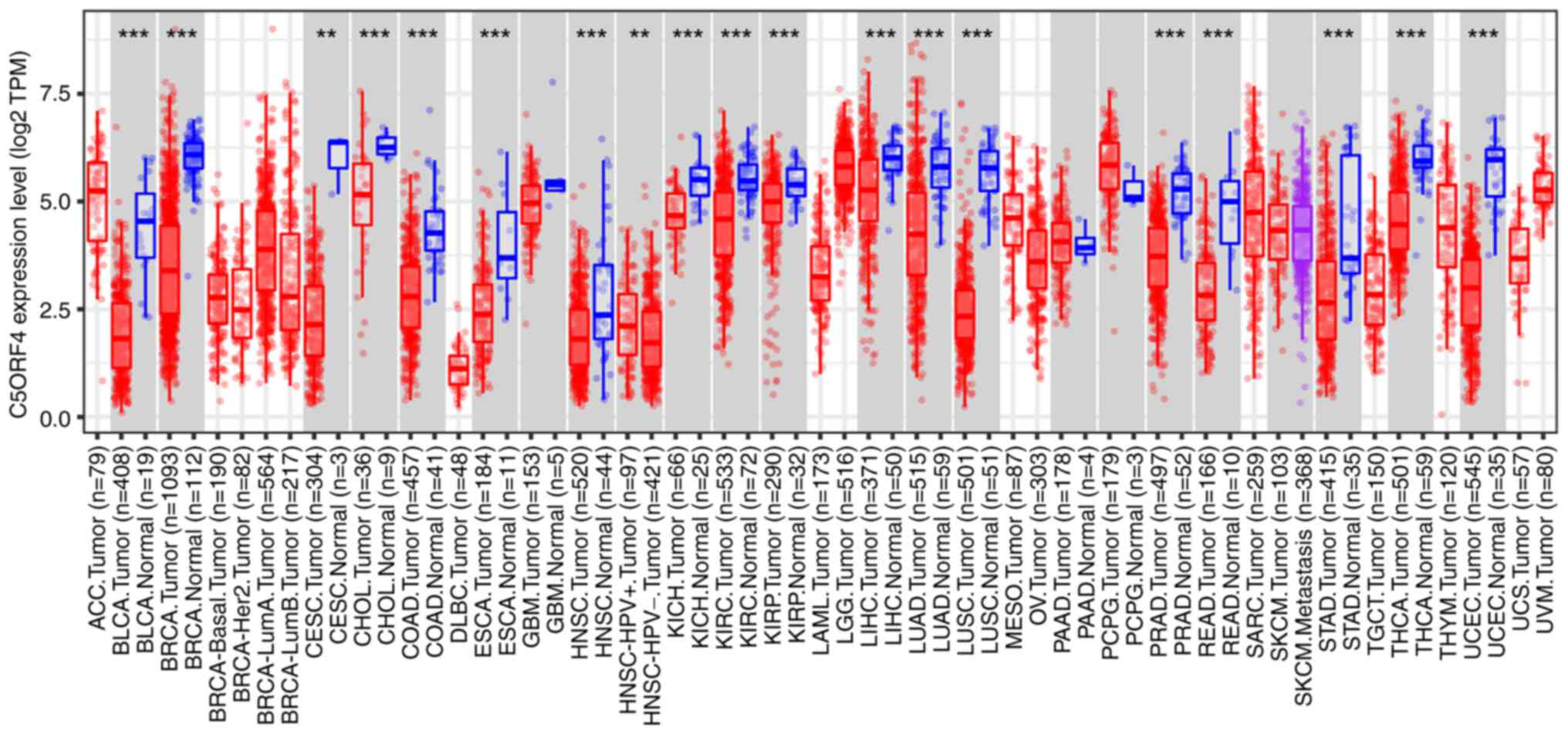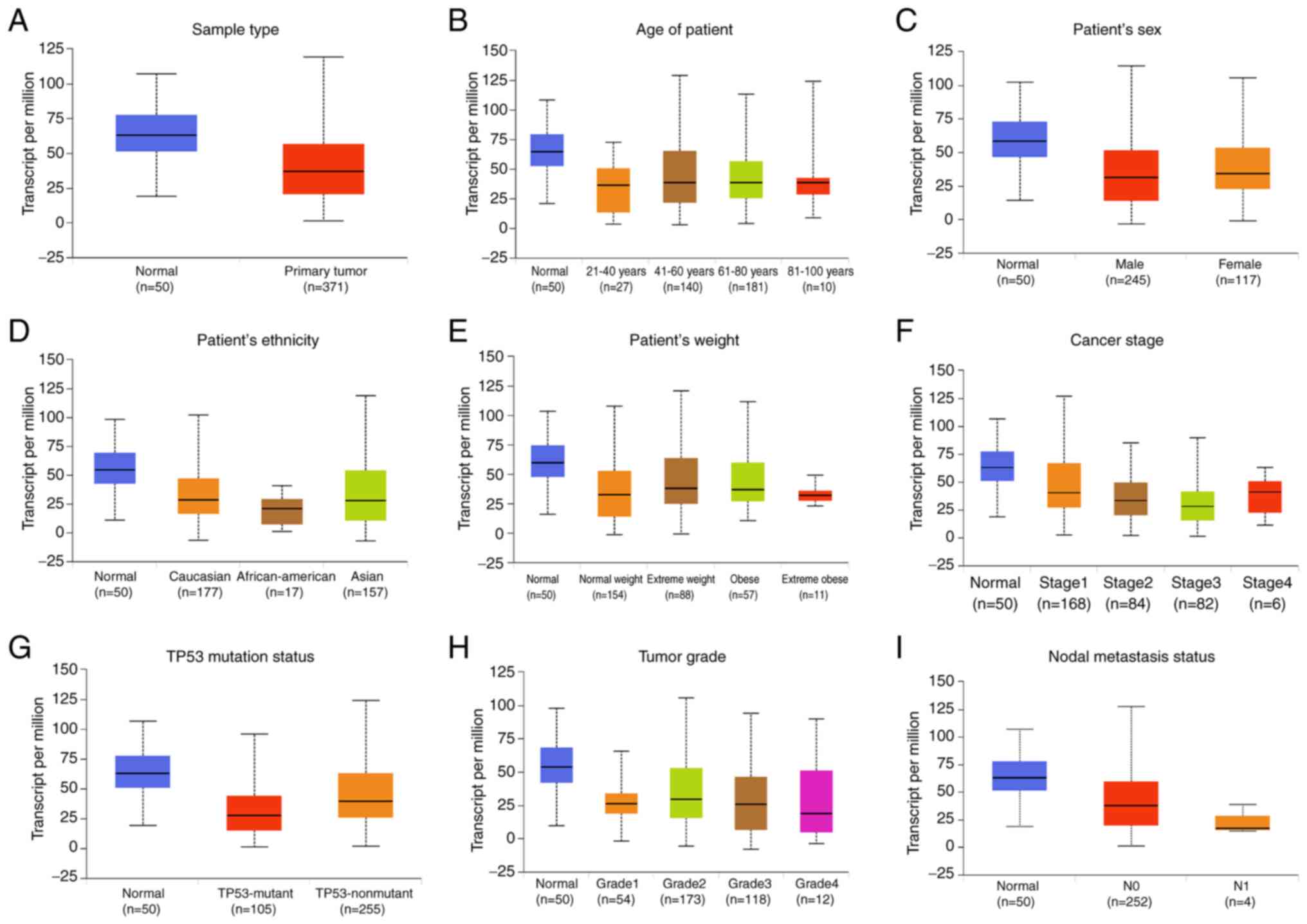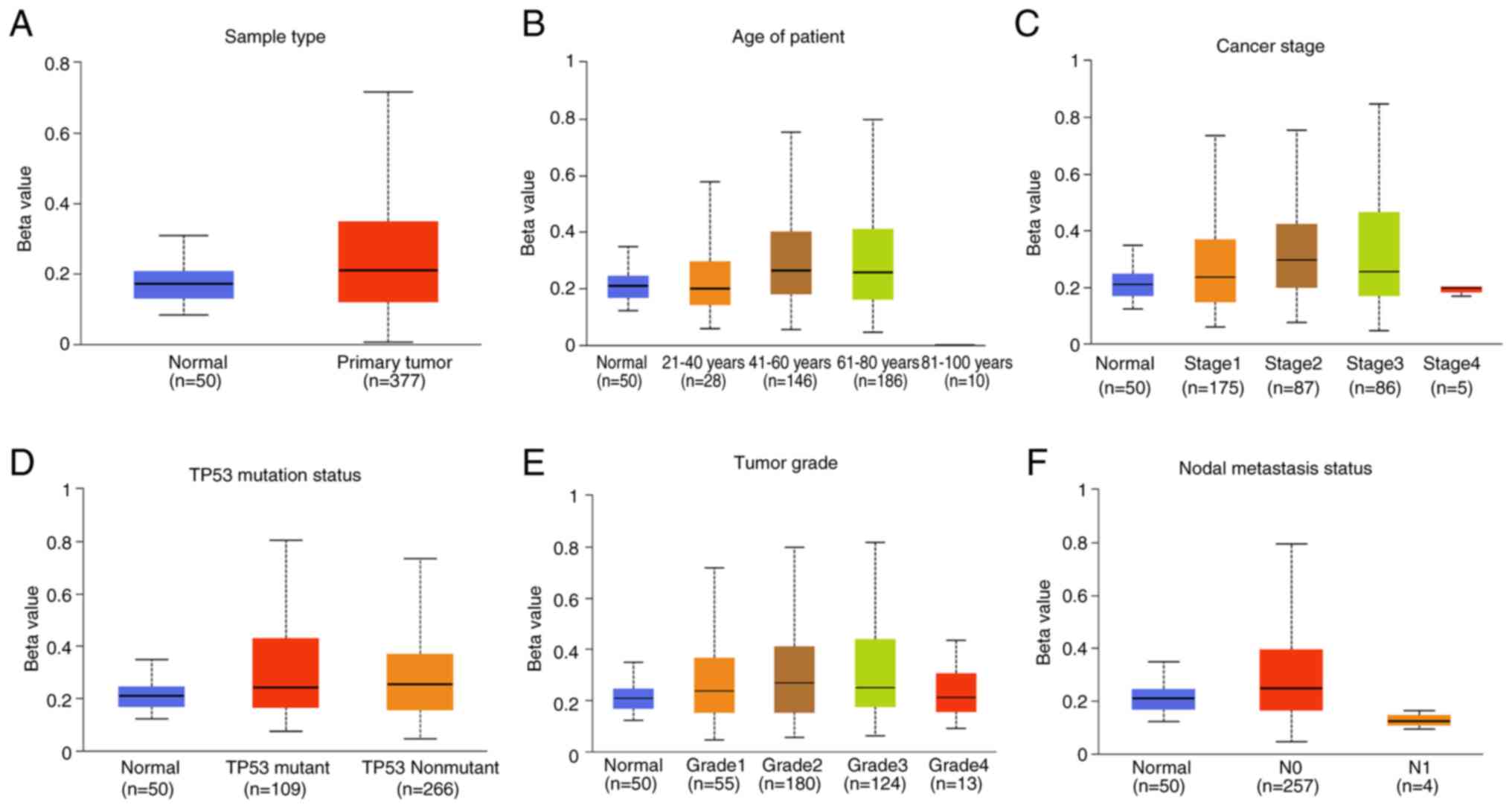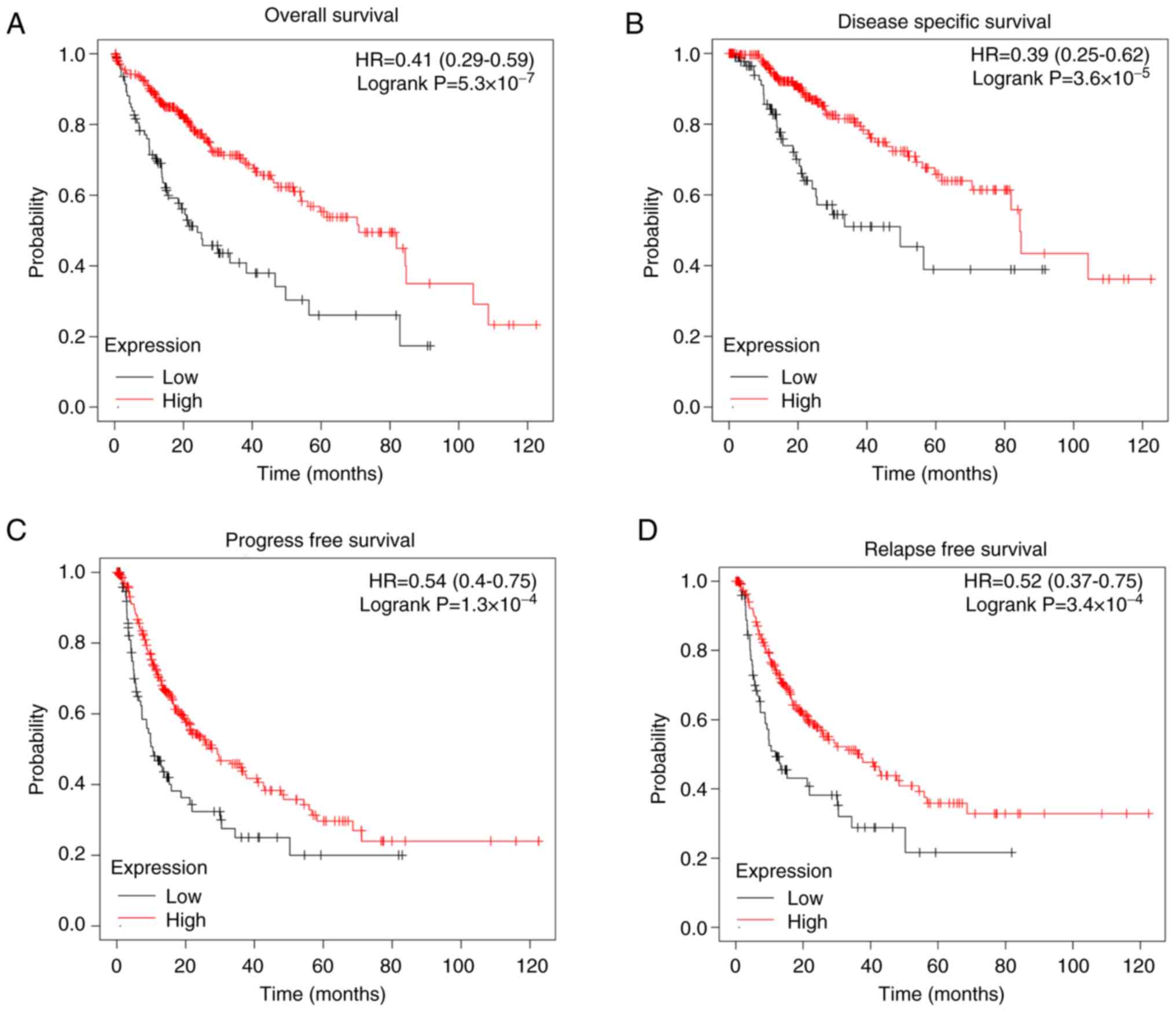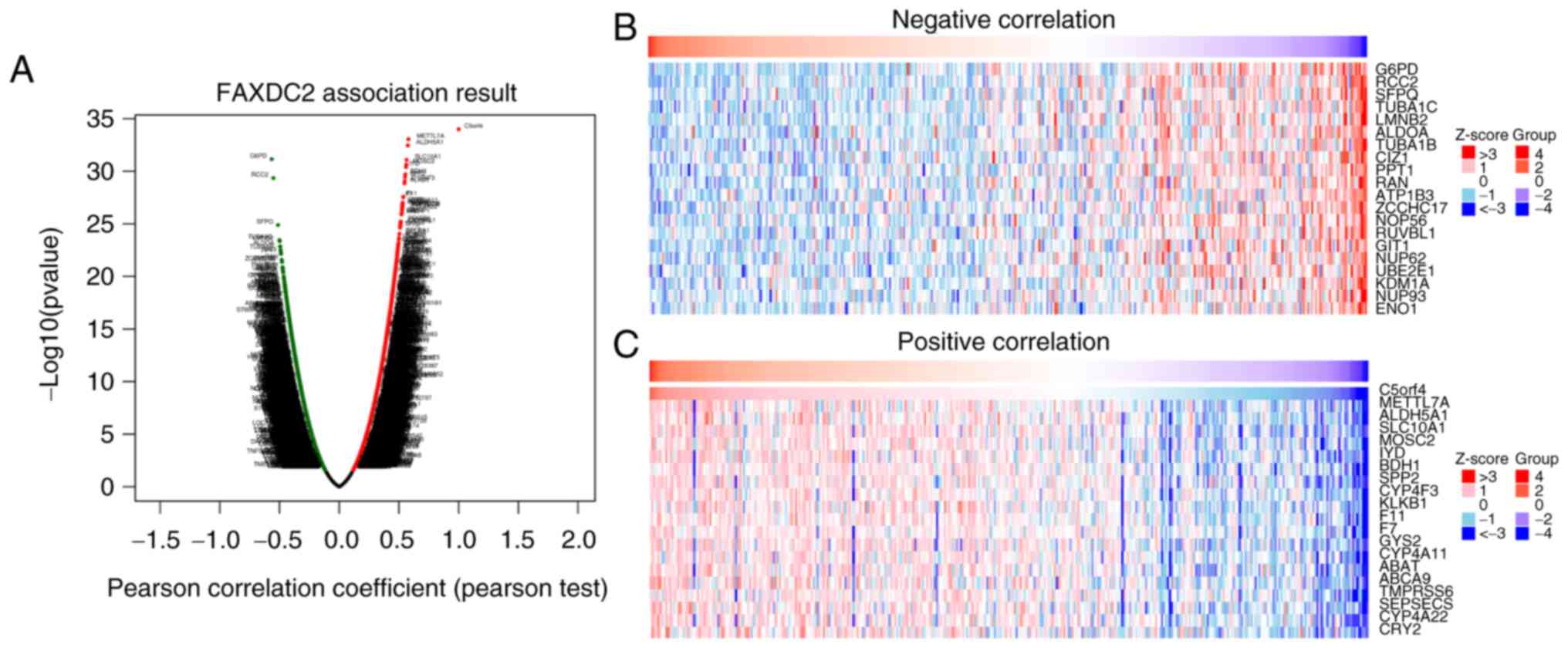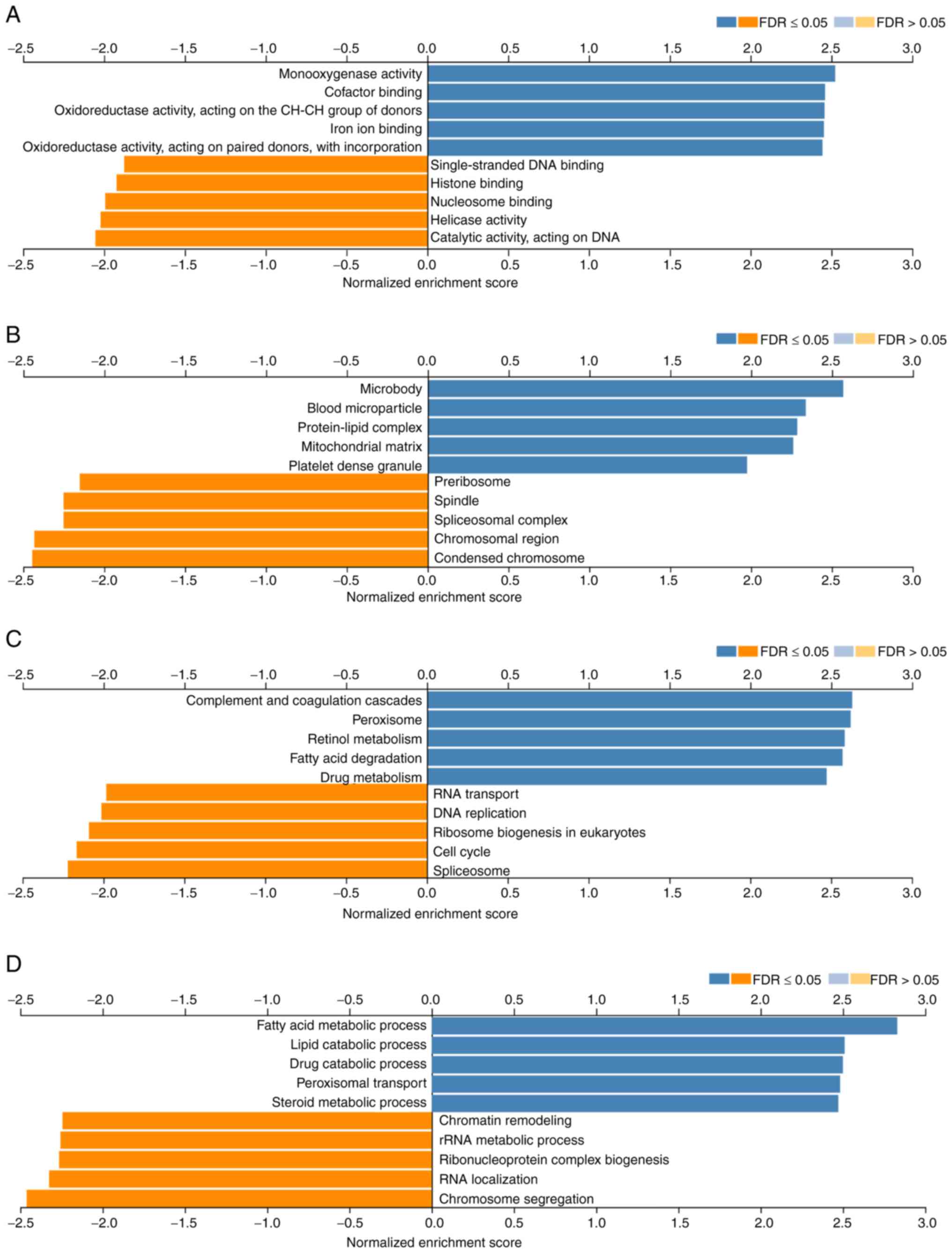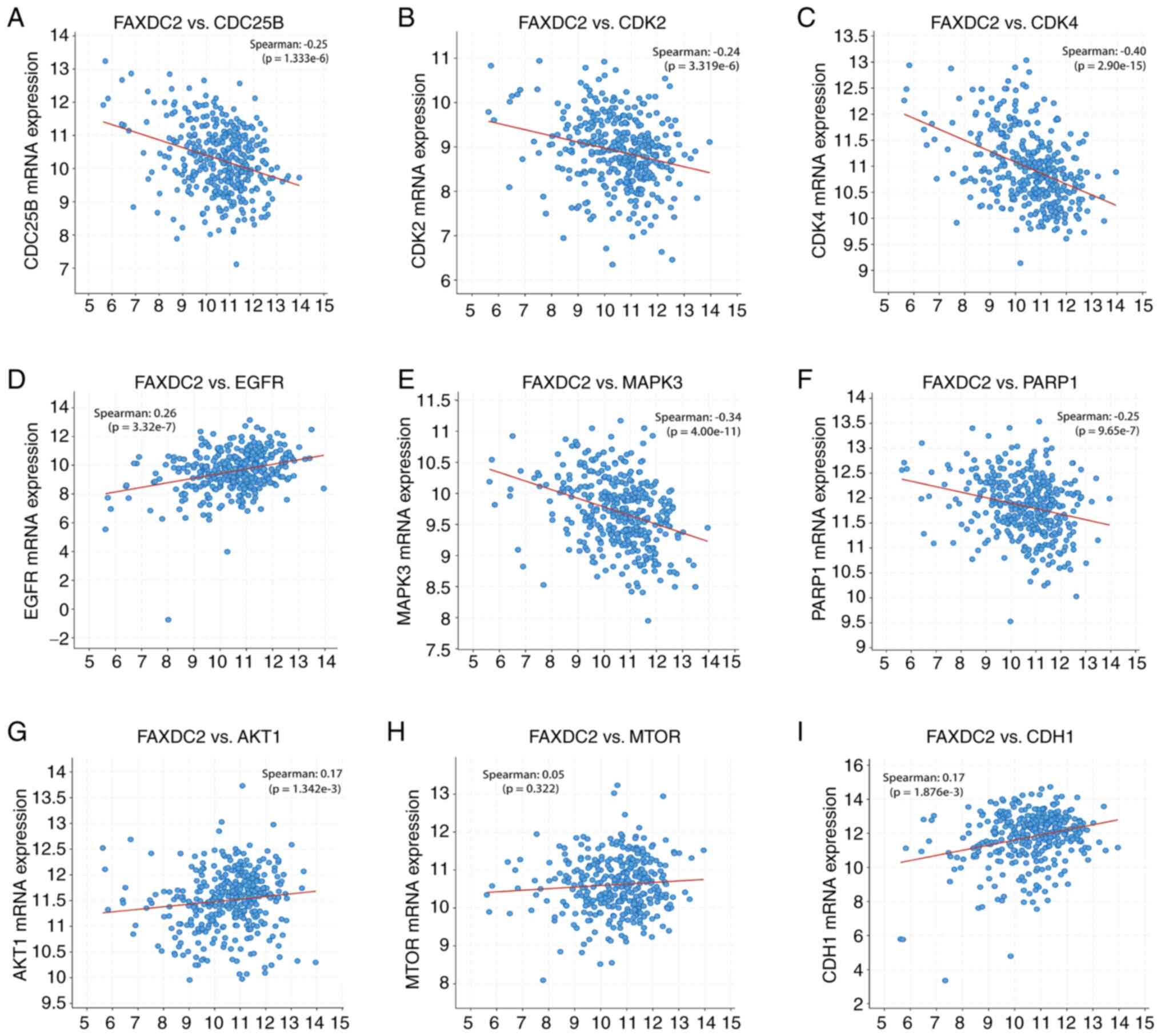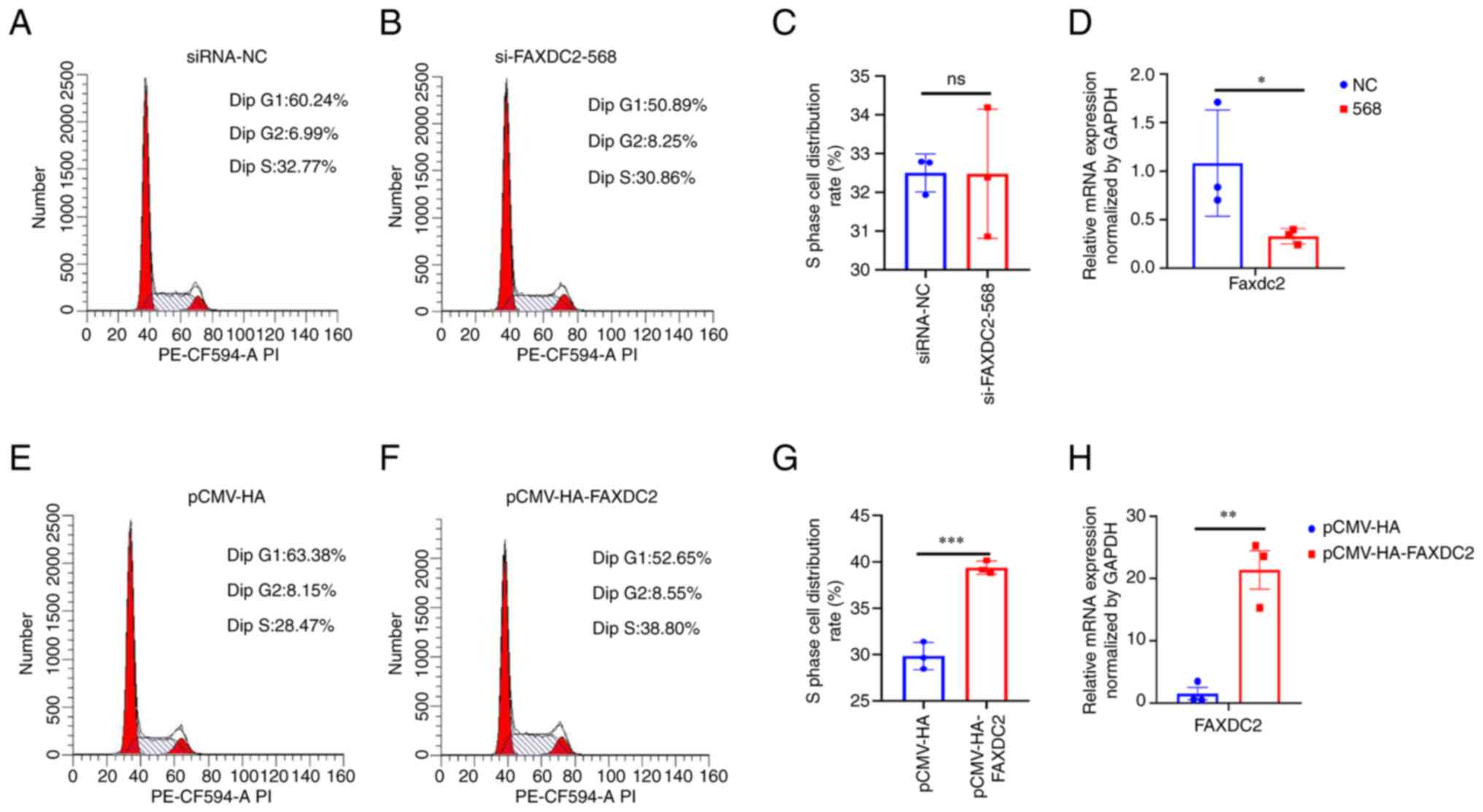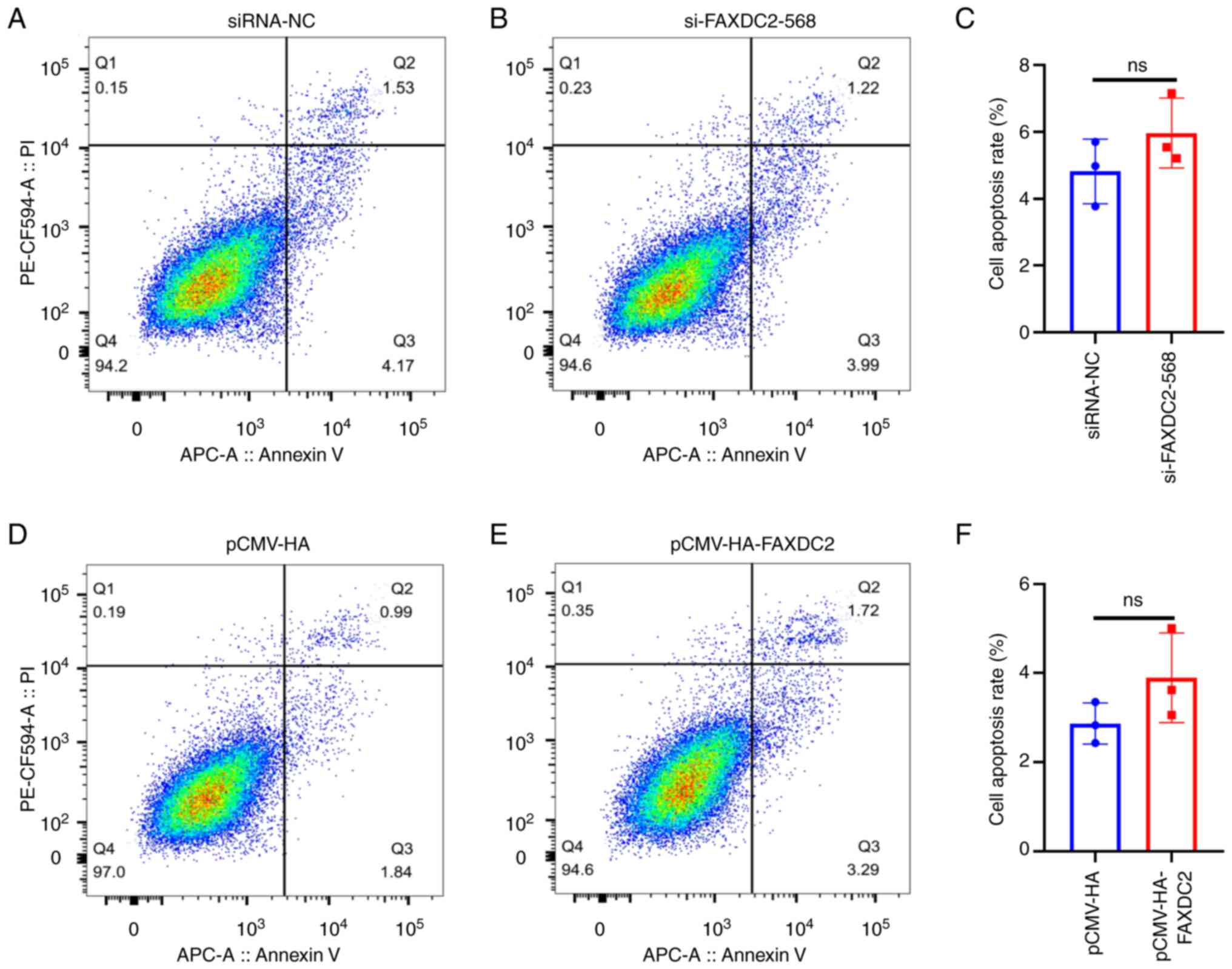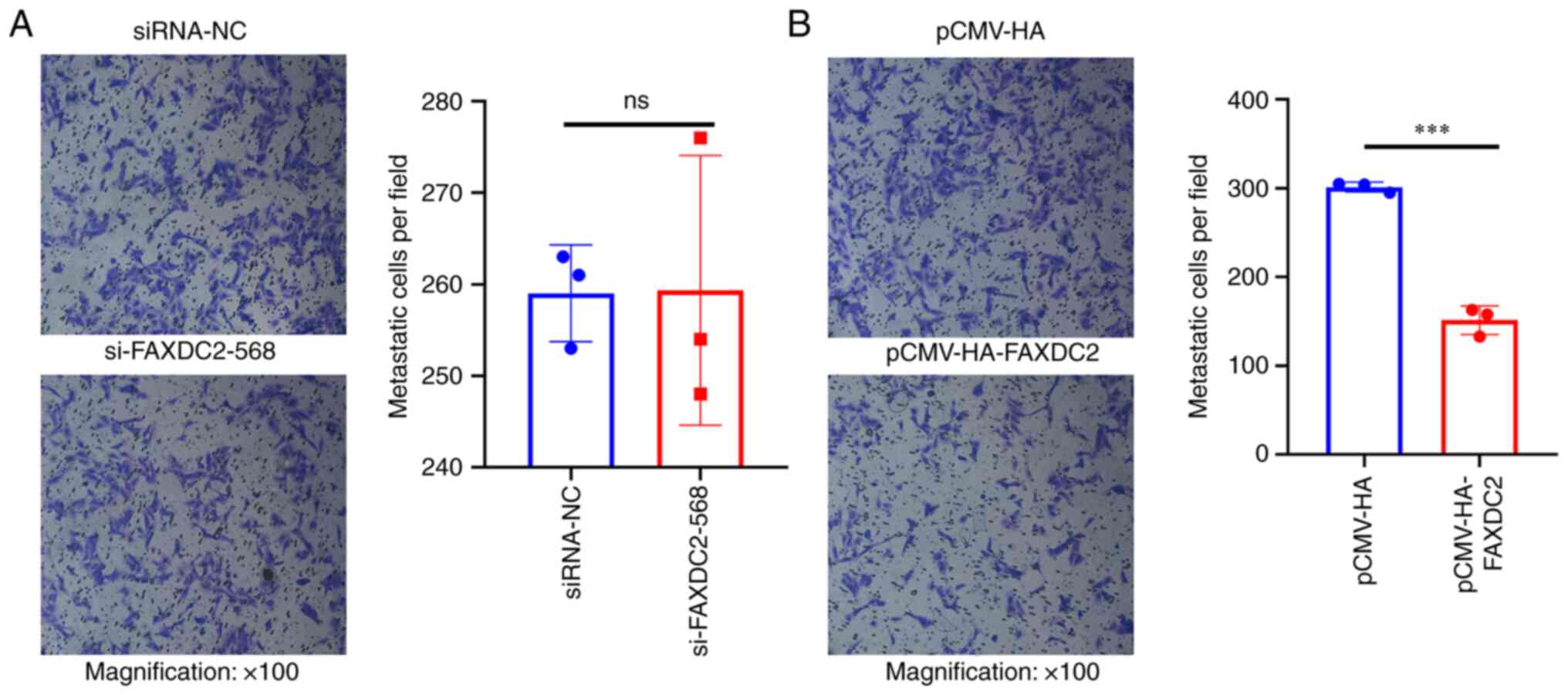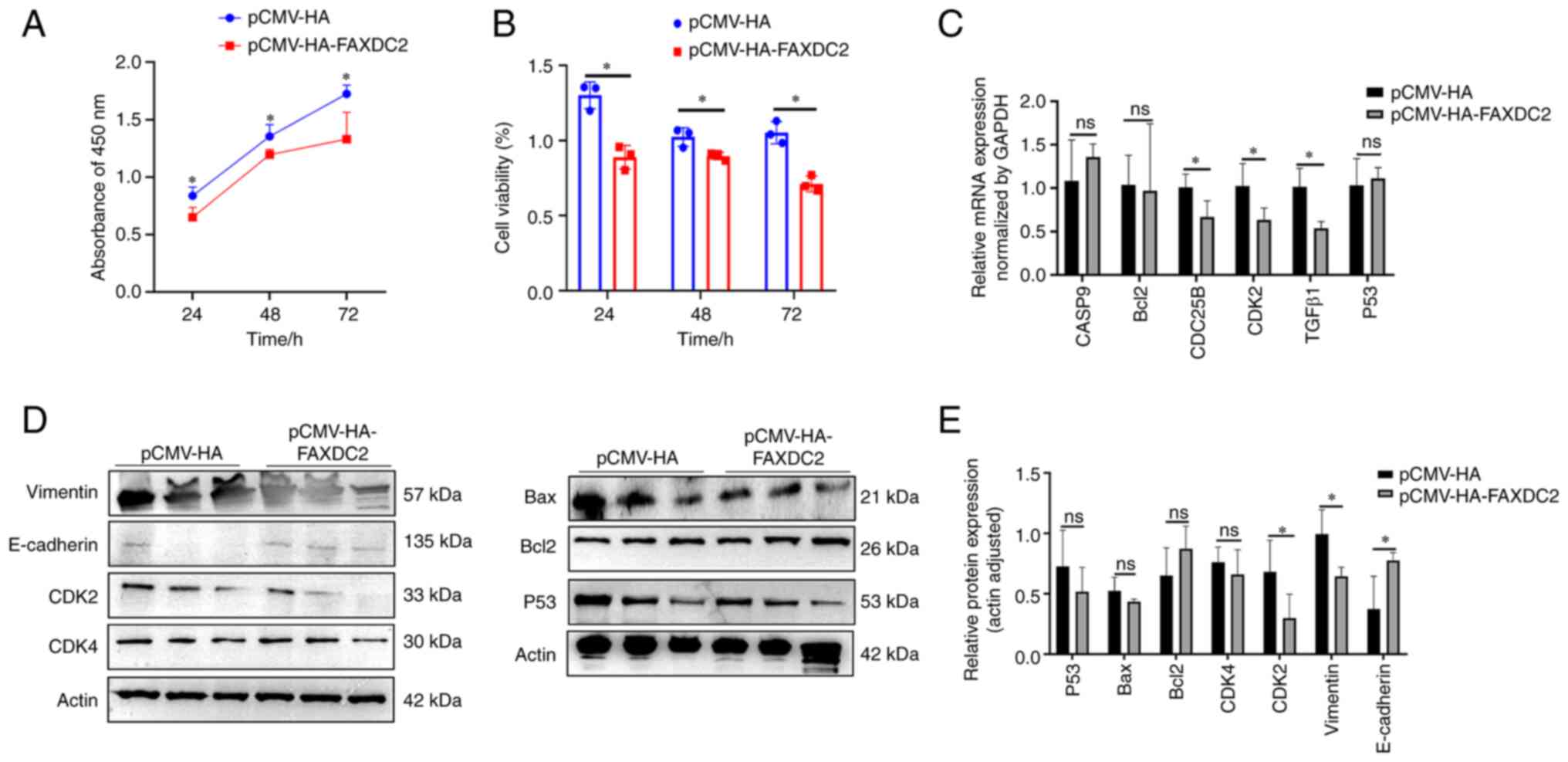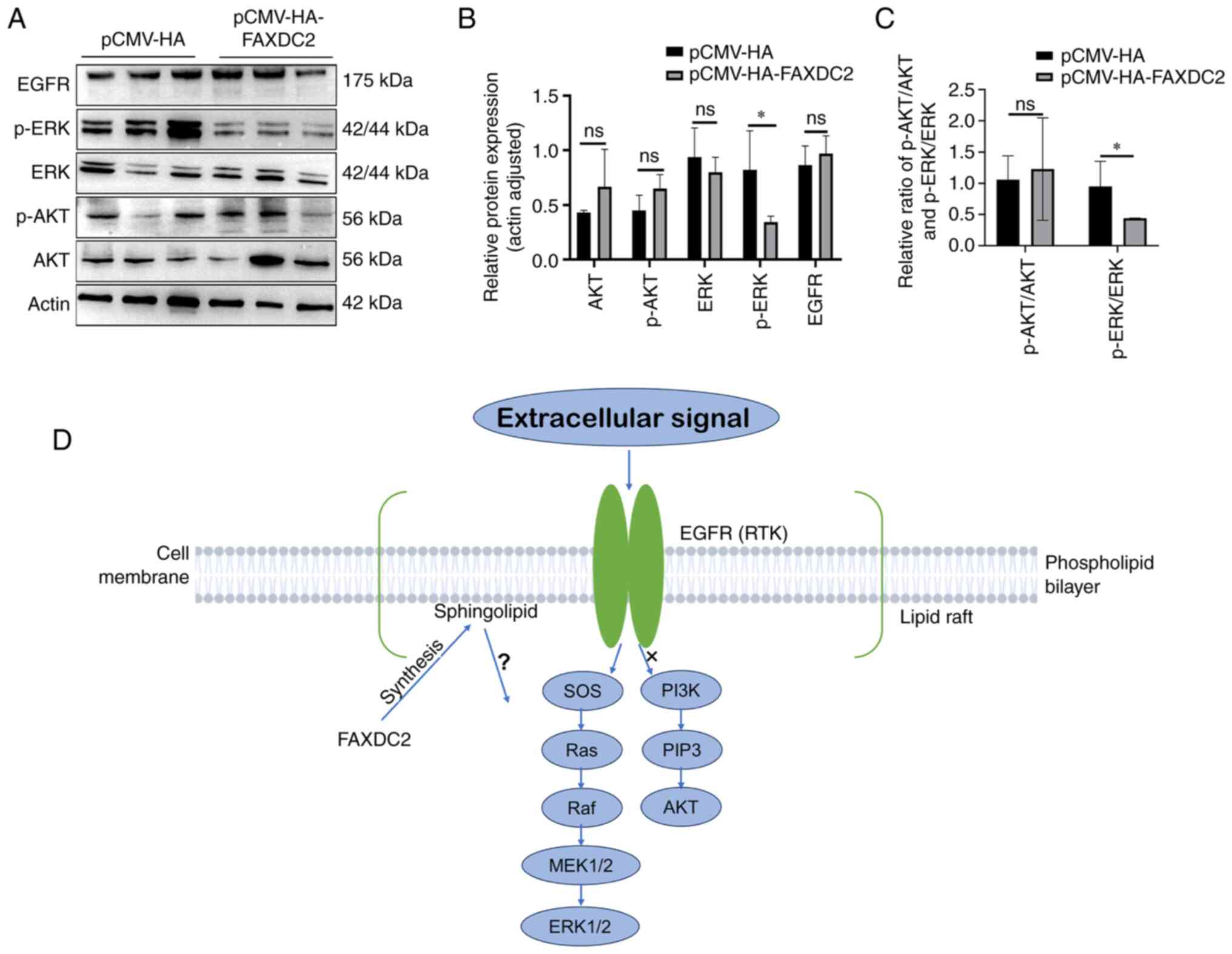FAXDC2 inhibits the proliferation and invasion of human liver cancer HepG2 cells
- Authors:
- Published online on: November 22, 2023 https://doi.org/10.3892/etm.2023.12315
- Article Number: 27
-
Copyright: © Peng et al. This is an open access article distributed under the terms of Creative Commons Attribution License.
Abstract
Introduction
Primary liver cancer is the sixth most commonly diagnosed cancer and the third leading cause of cancer death worldwide (1). Primary liver cancer mainly includes hepatocellular carcinoma (HCC) and intrahepatic cholangiocarcinoma (2-5). HCC accounts for 90% of primary liver cancer cases (6). The occurrence and development of liver cancer involves a variety of processes and pathways, including ERK, PI3K/ AKT and Wnt/β-catenin signaling pathways. These oncogenic signaling pathways can be activated by a variety of oncogenic drivers during liver carcinogenesis (7). Among them, the MAPK pathway acts on multiple links of tumor development by regulating the survival, senescence, proliferation, apoptosis, epithelial-mesenchymal transition (EMT), migration and invasion of cancer cells (8-11). A common hallmark of tumor growth signaling mediated by the Ras/Raf/MEK/ERK signaling axis in the MAPK pathway is the persistent activation of ERK1/2. Ras and Raf are well-known oncogenes and the Ras/Raf/MEK/ERK signaling pathway is activated in ~50% of patients with early liver cancer and almost all patients with advanced liver cancer (12). By specifically inhibiting MEK1 and then blocking ERK1/2 phosphorylation, the proliferation of liver cancer cells can be inhibited in a dose-dependent manner and its cytological effects involve cell cycle arrest, apoptosis and tumorigenicity (13).
It has been recognized that cancer cells maintain cell survival and reproduction by reorganizing lipid metabolism (14). The liver is the main organ for lipid metabolism and homeostasis maintenance and the role of lipid metabolism reprogramming in the occurrence of liver cancer has attracted much attention. During the transformation of non-alcoholic steatohepatitis into liver cancer, a variety of oncogenic signals and fatty acid metabolism signals are synergistically activated and targeting the lipoprotein lipase/fatty acid-binding protein 4/carnitine palmitoyltransferase I fatty acid metabolism signaling axis can prevent hepatitis from turning into liver cancer, it is suggested that the activation of fatty acid metabolism signaling axis is the initiation and maintenance factor of hepatocellular carcinogenesis (15). Mitochondria are a key place for lipolysis and anabolism. Mitochondrial fission can promote the shift of glucose metabolism from glycolysis to oxidative phosphorylation, thereby alleviating the energy pressure of tumor survival. Mitochondrial fission can promote fatty acid synthesis and inhibit fatty acid oxidation in liver cancer cells, regulate lipid metabolism reprogramming and promote proliferation, metastasis and tumor growth of liver cancer cells in vivo (16). Upregulation of fatty acid, cholesterol synthesis and fatty acid oxidation changes are the main characteristics of fatty acid metabolic re-programming (17,18). Signaling molecules in fatty acids and cholesterol metabolism regulation are becoming new therapeutic targets for liver cancer (19).
Fatty acid hydroxylase domain containing 2 (FAXDC2), also called C5orf4, is a member of the fatty acid hydroxylase superfamily. This family regulates the hydroxylation modification of fatty acids and generates 2-hydroxylated fatty acids by catalyzing the hydroxylation at the C2 position of fatty acids (20). One part of hydroxylated fatty acids enter the β-oxidation pathway for degradation, another part participates in the biosynthesis of cholesterol and sphingomyelin (21). In addition to energy storage, sphingolipids and steroids in lipids constitute the main components of biological membranes that are necessary for cell signal transduction (18). The region of cell membrane rich in cholesterol and sphingomyelin forms ordered functional microdomains, termed lipid rafts (LRs) (18). In response to external stimuli, the receptors and adapter proteins in the membrane are concentrated to the LRs, forming an orderly signal sorting center. Controlling the content of cholesterol and sphingomyelin can artificially achieve the dynamic remodeling of lipid rafts (22,23), thereby changing the transduction properties of intracellular signals. It has been reported that the expression of FAXDC2 is downregulated in prostate cancer and neuroblastoma and low expression of FAXDC2 is an unfavorable factor for disease prognosis (24,25). Another study has shown that FAXDC2 can regulate macrophage differentiation by regulating ERK signaling-related mechanisms (26). However, the roles of FAXDC2 in liver cancer remain unknown.
The present study attempted to combine bioinformatics and experimental biology strategies to explore the function and possible underling mechanism of FAXDC2 in the occurrence and development of hepatocellular carcinoma, in order to provide clues in finding fatty acid metabolic therapeutic targets for the disease diagnosis and treatment.
Materials and methods
Tumor Immune Estimation Resource (TIMER) 2.0
TIMER (http://timer.cistrome.org/) is an extensive tool designed for the systematic examination of immune infiltrates in different types of cancer using data from The Cancer Genome Atlas (TCGA) database. It consists of a collection of 10,897 samples from 32 types of cancer. In the present study, the Gene Differential Expression (Gene_DE) module was employed to evaluate the variations in expression of the FAXDC2 gene between tumor tissues and adjacent normal tissues across all TCGA tumors. The statistical significance of these differences was determined using the Wilcoxon rank sum test.
cBioPortal
The cBioPortal for Cancer Genomics (http://cbioportal.org) is a robust online platform that serves as a comprehensive resource for cancer genomics data derived from various platforms. The present study utilized the platform's summary information, plots and co-expression analyses for different types of cancer to investigate the expression of the FAXDC2 gene in cancer.
LinkedOmics analysis
LinkedOmics (linkedomics.org) is an open-access portal that integrates multi-omics and clinical data sourced from the TCGA project, comprising data from 11,158 patients across 32 types of cancer. For the present study, the LinkFinder tab within LinkedOmics was used to identify genes that were differentially expressed (DEGs) in association with FAXDC2. The search and target datasets used in the analysis were derived from RNA sequencing (RNA-seq). To determine the significance of the findings, statistical analyses using Pearson's and Spearman's correlation tests were conducted. Additionally, the LinkInterpreter tab was employed to perform over-representation enrichment analysis and gene set enrichment analysis (GSEA).
Kaplan-Meier plotter
The Kaplan-Meier plotter (http://kmplot.com/analysis) is a powerful tool that enables the assessment of the effects of 54K genes (mRNA, miRNA and protein) on survival outcomes across 21 different types of cancer. The data sed in this tool are sourced from various databases, including Gene Expression Omnibus, European Genome-phenome Archive and TCGA. The primary objective of this tool is to identify and validate survival biomarkers through a meta-analysis approach. To generate the Kaplan-Meier plots, the ‘survplot’ R package (http://www.cbs.dtu.dk/~eklund/survplot/) was employed. Statistical significance was evaluated using log-rank testing.
UALCAN analysis
UALCAN (ualcan.path.uab.edu/index.html) is a user-friendly web portal that facilitates comprehensive analyses of TCGA gene expression data, incorporating TCGA level 3 RNA-seq data and clinical information from 31 different types of cancer. the present study, UALCAN was employed to examine the relative expression of the FAXDC2 gene within normal samples and across specific tumor subgroups, including cervical squamous cell carcinoma and endocervical adenocarcinoma (LIHC).
Western blotting
Cellular proteins were extracted using RIPA lysis buffer (Elabscience Biotechnology, Inc.). The protein concentrations were determined using the BCA assay. For gel electrophoresis, protein samples (10-25 µl/sample) were loaded onto a 10% acrylamide gel. Electrophoresis was conducted at a constant voltage of 80 V until the target protein bands were adequately separated. Following electrophoresis, the proteins were transferred onto nitrocellulose (NC) membranes using a constant current of 300 mA. The NC membranes were then immersed in Tris-buffered saline (TBST) containing 0.05% Tween 20 and 5% skimmed milk for 1.5 h at room temperature. After removing excess milk, the NC membrane was incubated with primary antibody (1:1,000) at room temperature for 90 min. Subsequently, the membrane was washed three times with TBST for 5 min each. Next, the NC membrane was incubated at room temperature for 90 min with the secondary antibody (diluted at a volume ratio of 1:5,000), followed by three washes with TBST for 5 min each. Super-sensitive ECL chemiluminescent substrate (Biosharp, cat. no. BL520A) was applied to the film for imaging. Densitometry was performed using ImageJ 1.52a software (http://imagej.org, National Institutes of Health).
The anti-Phospho-p44/42 MAPK (Erk1/2) (cat. no. 4370), anti-(BCL-2) (cat. no. 4223), anti-p44/42 MAPK (Erk1/2) (cat. no. 4695), anti-CDK4 (cat. no. 12790), anti-CDK2 (cat. no. 2546), anti-E-Cadherin (cat. no. 3195), anti-p-AKT (cat. no. 9271) and anti-AKT (cat. no. 9272) antibodies were purchased from Cell Signaling Technology, Inc. The anti-p53 antibody was purchased from ProteinTech Group, Inc. (1:1,000; cat. no. 10442-1-AP), the anti-Vimentin (cat. no. T55134), anti-EGFR (cat. no. T55112) antibodies were purchased from Abmart Biomedicine (Shanghai) Co., Ltd. and the anti-BAX antibody was purchased from Boster Biological Technology (cat. no. BA0315-2). ACTIN was used as internal references, and antibody was purchased from Abmart Biomedicine (Shanghai) Co., LTD. (1:1,000; cat. no. M20011). Goat anti-mouse IgG HRP-conjugated and anti-rabbit IgG HRP-conjugated secondary antibodies were purchased from CWBio (1:5,000; cat. nos. CW0102 and CW0103).
RNA extraction and reverse transcription-quantitative (RT-q) PCR
Total RNA was isolated using the Vazyme RNA extraction kit (Vazyme Biotech Co., Ltd.) according to the manufacturer's protocol. cDNA was synthesized using the Vazyme cDNA synthesis kit (Vazyme Biotech Co., Ltd.) according to the manufacturer's protocol. Real-time PCR was conducted using SYBR Premix Ex Taq II (Takara Bio, Inc.) according to the manufacturer's protocol. The TaqMan qPCR cycling conditions were as follows: 50̊C for 2 min, 95̊C for 5 min, followed by 40 cycles at 95̊C for 15 sec-40 cycles, 60̊C for 40 sec-40 cycles. The primers utilized in the PCR analysis were obtained from TsingKe Biological Technology. The expression level of GAPDH is used as an internal reference for quantification, and the relative expression of related genes was calculated using the 2-ΔΔCq method (27). The specific primer sequences are provided in Table SI. This experiment was replicated three times.
Cell culture and transfection
Hepg2 cells were maintained in Dulbecco's Modified Eagle's Medium (DMEM; Gibco; Thermo Fisher Scientific, Inc.) supplemented with 10% fetal bovine serum [FBS; Serana (WA) Pty. Ltd.]. The cells were cultured at a temperature of 37˚C in a humidified incubator with 5% CO2. Transfection of Hepg2 cells was performed using Lipofectamine® 2000 (Invitrogen; Thermo Fisher Scientific, Inc.) according to the manufacturer's protocol, cell density, approximately 80%, with 5 µg of plasmid per dish at room temperature for 10 min. FAXDC2 overexpression was achieved by inserting the coding sequence (CDS) of human FAXDC2 into the pCMV-HA vector (Agilent Technologies, Inc.) to generate pCMV-HA-FAXDC2, pCMV-HA was used as a negative control for overexpression. For FAXDC2 knockdown, specific short interfering (si)RNA targeting FAXDC2 was synthesized by Sangon Biotech Co., Ltd. Transfection of siRNA was performed using Lipofectamine® RNAiMAX (Invitrogen; Thermo Fisher Scientific, Inc.) according to the manufacturer's instructionsat room temperature for 10 min and then place it in a 37̊C incubator for 48 h. The sequences of the siRNAs used are provided in Table SII.
CCK-8 assay for cell viability
Cell viability of HepG2 cells was assessed using Cell Counting Kit-8 (CCK-8; Beyotime Institute of Biotechnology). Following transfection with the plasmid vector, the cells were incubated for 24, 48 and 72 h. After the respective time points, 20 µl of CCK-8 reagent was added to each well and the cells were then incubated for 1 h at 37˚C in a CO2 incubator. The absorbance of the medium was quantified at a wavelength of 450 nm using a microplate reader (Bio-Rad Laboratories, Inc.) This measurement was used to evaluate cell viability.
Flow cytometry
Flow cytometry was employed to evaluate cell cycle progression and apoptosis 24 h after cell transfection. For cell cycle analysis, a total of 5,000 cells were fixed, stained with propidium iodide at 37̊C water bath for 30 min, and analyzed using Becton Dickinson (BD) FACS Calibur flow cytometry (BD Biosciences). To assess apoptosis, the Annexin V Apoptosis Detection Kit (BD Biosciences) was used following the manufacturer's instructions, by treating with Annexin V on ice for 10 min, then adding propidium iodide, mixing, and ice Let stand for 5 min before performing flow cytometry analysis. For this assay, 5x104 cells were labeled with annexin V and propidium iodide and then subjected to flow cytometry analysis. Flow cytometry analysis of apoptosis was performed using FLOWJO version 10.8.1 (flowjo.com/), and flow cytometry analysis cycle was performed using MODFIT LT version 4.0.5 (https://www.solvusoft.com/zh-cn/file-extensions/software/verity-software-house/). The apoptosis rate is a comparative analysis by calculating the percentage of early + late apoptotic cells.
Cell migration and invasion assays
To conduct cell migration and invasion assays, 24-well plates with 8 µm chambers inserted into each well (Corning, Inc.) were used. For migration assays, 5x104 cells were directly added to the upper chamber. In invasion assays, an additional layer of Matrigel was applied to the insert to establish a matrix barrier at 37̊C for 3 h, followed by seeding 1x105 cells into the upper chamber. Further, 800 µl of DMEM supplemented with 10% FBS was added to each lower chamber. The cells were then incubated at 37˚C for a specific duration to allow migration or invasion. The cells that migrated or invaded through the chambers were fixed and stained using 0.1% crystal violet and 20% methanol for 30 min at room temperature in the dark. Subsequently, the cells were observed and counted under an inverted microscope (Nikon Eclipse; Nikon Corporation).
Vector construction
The CDS region of the FAXDC2 gene was amplified using the polymerase chain reaction (PCR) method and homologous recombination was performed simultaneously. The homologous recombination reagent from Vazyme Biological Company was used for this purpose. The amplified CDS region was then inserted into the pCMV-HA vector (Promega Corporation). To validate the sequence integrity and accuracy of the constructed vector, Sanger sequencing analysis was performed by Tsingke Biotechnology Co, Beijing, China.
Statistical analysis
Statistical analysis was performed using GraphPad Prism 8.0 software (GraphPad Software; Dotmatics). The data are expressed as mean ± standard deviation. Differences between two groups were evaluated using unpaired t-tests. In TIMER 2.0, the Wilcoxon rank sum test was employed. Each experiment was repeated a minimum of three times to ensure reproducibility. The significance of survival curves was assessed using the log-rank test. For LinkedOmics analysis, Pearson and Spearman's correlation tests were used. Spearman's correlation test was used for cBioPortal analysis. P<0.05 was considered to indicate a statistically significant difference.
Results
The expression of FAXDC2 is downregulated in tumor tissues
TIMER2.0 was employed to conduct an analysis comparing the expression of FAXDC2 in various human tumor tissues with normal tissues. Compared with normal tissues, FAXDC2 exhibited significant downregulation in several types of cancer, including lung squamous cell carcinoma, lung adenocarcinoma, hepatocellular carcinoma (LIHC), prostate cancer, colorectal cancer, cervical squamous cell carcinoma and endocervical adenocarcinoma, as well as 18 other types of tumor tissue where it consistently demonstrated significant downregulation (Fig. 1). This suggested that FAXDC2 may have a relatively conserved role in carcinogenesis.
Considering the involvement of FAXDC2 in the pathway of fatty acid synthesis and the significance of the liver in fat synthesis and metabolism, LIHC was selected to explore the role of FAXDC2 in cancer. UALCAN was used to classify LIHC samples from the TCGA database based on sample type, cancer stage, body weight, age, tumor grade and lymph node metastasis status. Expression of FAXDC2 was lower in various LIHC subgroups Compared with normal tissues (Fig. 2). Moreover, the methylation level of the FAXDC2 gene promoter was observed to be higher in various types of cancer tissue compared with normal tissues (Fig. 3).
High expression of FAXDC2 in LIHC patients has good prognosis
To explore the prognostic significance of FAXDC2 in LIHC, the present study conducted Kaplan-Meier survival analysis. The LIHC cohort was divided into subgroups based on the expression level of FAXDC2. The results revealed that patients with low expression of FAXDC2 had a poorer prognosis compared with other subgroups. Kaplan-Meier survival curves (Fig. 4) demonstrated that LIHC patients with high FAXDC2 expression had longer overall survival [OS; hazard ratio (HR)=0.41 (0.29-0.59); P=5.3 x10-7], disease-free survival [DSS; HR=0.39 (0.25-0.62), P=3.6 x10-5], progression-free survival [PFS; HR=0.54 (0.4-0.75), P=1.3 x10-4] and recurrence-free survival [RFS; HR=0.52 (0.37-0.75), P=3.4 x10-4] compared with those with low FAXDC2 expression.
Collectively, these results indicated that high expression of FAXDC2 is closely associated with favorable clinical outcomes in LIHC patients, suggesting its potential as a valuable prognostic biomarker.
Differentially expressed genes related to FAXDC2
In LIHC, the present study identified genes associated with FAXDC2 using LinkedOmics and displayed them in a heatmap (28). As shown in the volcano plot (Fig. 5A), the top 50 differentially expressed genes or negatively or positively correlated genes were significantly expressed and the top 20 correlated differentially expressed genes were shown in the heatmap (Fig. 5B and C).
Functional enrichment analysis of FAXDC2
Next, gene ontology analysis was performed using the GSEA LinkInterpreter module to classify FAXDC2-related genes into three categories based on molecular functions, involved biological processes and cellular locations where they occur. The five up- or downregulated pathways for each pathway were as follows. Those mainly involved in molecular functions, showed upregulation in molecular functions such as oxidoreductase activity, iron ion binding and cofactor binding and in monooxygenase activity, single-strand DNA binding, histone binding, nucleosome binding and helicase activity. Molecular functions such as catalytic activity acting on DNA were downregulated (Fig. 6A). In the category of cellular components, the FAXDC2-related genes were mainly enriched and upregulated in cellular components such as microsomes, blood particles, protein-lipid complexes, mitochondrial matrix and platelet dense granules, while downregulated in chromatin, spindle, spliceosome complexes and pre-ribosomes (Fig. 6B). Further analysis revealed functional KEGG pathways that may be involved in the development and progression of LIHC, including complement and coagulation cascades, peroxisomes, retinol metabolism, fatty acid degradation; upregulated in pathways such as drug metabolism and downregulated in pathways such as RNA transport, DNA replication, ribosome biogenesis in eukaryotes, cell cycle and spliceosome (Fig. 6C). In the biological process category, FAXDC2 related differentially expressed genes were mainly enriched in peroxisome transport, amino acid metabolism, lipid catabolism, drug catabolism, steroid metabolism, regulation of chromosome organization, chromatin reorganization plasticity, rRNA metabolic process and RNA localization (Fig. 6D).
In summary, the differential expression of FAXDC2 in LIHC tissues involved ab-normal changes in multiple signaling pathways and biological processes.
FAXDC2 is associated with multiple signaling pathways involved in cancer regulation
To identify FAXDC2 as a putative cancer regulator, common signaling pathways or key regulators that are aberrantly expressed in tumors were investigated. It is known that PI3K, ERK and other signaling pathways or signal transduction pathways are often abnormally expressed in LIHC tissues (13,29,30). Therefore, we conducted co-expression analysis of key regulatory molecules of these signaling pathways and FAXDC2 was performed.
In LIHC, the cBioPortal platform was used to correlate the expression level of FAXDC2 with key molecules aberrantly expressed in tumor tissue (such as CDC25B, CDK2, CDK4, AKT1, TNFα, MAPK3 and PARP1). Finally, it was found that key regulators in tumorigenesis, such as AKT1 and MAPK3, were significantly associated with the expression of FAXDC2 in LIHC (Fig. 7). Pearson correlation coefficient analysis showed that the expression level of FAXDC2 was negatively correlated with the expression levels of CDC25B, CDK2, CDK4, MAPK3 and PARP1, positively correlated with the expression levels of EGFR, AKT1 and CDH1, but had no significant correlation with MTOR. These results suggested that FAXDC2 may affect cancer progression through multiple signaling pathways and is closely related to life activities such as cell proliferation, migration and apoptosis.
Overexpression of FAXDC2 regulates cycle distribution of HepG2 cells
In order to verify the association between FAXDC2 and liver cancer from an experimental point of view, the present study overexpressed and silenced HepG2 cells and per-formed flow cytometry to analyze the cycle changes of HepG2 cells, as shown in the Fig. 8. The cycle distribution of HepG2 cells treated with si-FAXDC2-568 and FAXDC2 overexpression was detected by flow cytometry and it was found that the cell cycle distribution of si-FAXDC2 had no significant change, while the number of cells in S phase of cells overexpressing FAXDC2 increased significantly and the number of cells in G1/G0 phase significantly decreased. This indicated that the overexpression of FAXDC2 can regulate the cell cycle distribution. In addition, through the detection of cell apoptosis, it was found that the apoptosis rate of HepG2 cells treated with overexpression of FAXDC2 has no significant change compared with the control group and the apoptosis rate of HepG2 cells treated with si-FAXDC2 had no significant change (Fig. 9).
Overexpression of FAXDC2 inhibits HepG2 cell invasion
In order to detect the effect of endogenous differential expression of FAXDC2 in HepG2 cells on the invasion function of HepG2 cell lines, Transwell was used to detect the effect of FAXDC2 on the invasion ability of HepG2 cells. Compared with the control group, the invasive ability of HepG2 cells knocked down by FAXDC2 had no significant change (Fig. 10A) and HepG2 cells treated with overexpression of FAXDC2 had weaker invasive ability (Fig. 10B).
Overexpression of FAXDC2 inhibits proliferation of HepG2 cells
The above results suggested that FAXDC2 plays an inhibitory role in the occurrence and development of liver cancer. In order to verify whether the overexpression of FAXDC2 leads to the weakening of cell proliferation through arresting the cell cycle, CCK-8 assay was then performed on HepG2 cells (Fig. 11A and B). The results showed that after overexpression of FAXDC2, the number of living cells was significantly reduced compared with the control, suggesting that FAXDC2 reduced the proliferation activity of HepG2 cells. To reveal how the overexpression of FAXDC2 regulated the proliferation and invasion ability of HepG2 cells at the molecular level, the changes in the expression levels of genes related to proliferation, invasion and apoptosis at the protein and mRNA level were detected by western blotting and qPCR (Fig. 11C-E), as shown in the figure, after overexpressing FAXDC2 to treat HepG2 cells, the expression of Vimentin and TGFβ1 related to invasion and EMT were significantly downregulated, the protein expression levels of E-cadherin were significantly upregulated and the expression levels of cycle-related proteins CDK2 and CDC25B were significantly downregulated, while the genes related to apoptosis such as P53, Bax, Bcl2 and CASP9 demonstrated no significant changes.
Overexpression of FAXDC2 inhibits ERK signaling in liver cancer cells
Based on the previous analysis results of the cBioPortal platform it was hypothesized that FAXDC2 may exert cell biological functions through AKT or ERK signaling in the process of liver cancer. The effect of FAXDC2 overexpression on ERK signaling and AKT signaling was then evaluated by western blotting (Fig. 12). The results of western blotting (Fig. 12A and B) showed that following the overexpression of FAXDC2, the expression level of p-ERK was significantly downregulated and the expression levels of AKT, p-AKT and EGFR showed no significant change, which indicated that FAXDC2 may be activated in the HepG2 cell line through Inhibit ERK phosphorylation to play an inhibitory effect on liver cancer (Fig. 12C).
Discussion
The reprogramming of lipid metabolism plays an important role in the occurrence and development of liver cancer. As a member of the fatty acid hydroxylase family, FAXDC2 has a potential role in the synthesis of cholesterol and sphingomyelin. Although more attention has been paid to FAXDC2 in the past decade, its function in liver cancer has not been investigated. The present study explored the role of FAXDC2 in the development of liver cancer based on bioinformatics and experimental biology. It produced the following findings: i) In the majority of cancer tissues, including liver cancer, FAXDC2 demonstrated downregulation and its low expression was found to be associated with a detrimental prognosis in cancer patients. ii) The presence of FAXDC2 exhibited inhibitory effects on the proliferation, migration and invasion of liver cancer cells. iii) It is possible that FAXDC2 exerted its influence on the growth of liver cancer cells by suppressing the ERK signaling pathway.
The expression of FAXDC2 is inversely correlated with the development of liver cancer
Bioinformatics results showed that FAXDC2 is expressed in 18 cancer tissues including lung squamous cell carcinoma, lung adenocarcinoma, liver cancer, prostate cancer and colorectal cancer. This suggested that FAXDC2 might have a universal function in cancer and the liver, as the main site of fatty acid synthesis and metabolism, and this has become a key research target of the authors. Meanwhile, abnormally high levels of FAXDC2 gene promoter methylation were detected in a number of LIHC subgroups by UALCAN analysis, suggesting that epigenetic downregulation of FAXDC2 might contribute to the development of LIHC. Through Kaplan-Meier plotter analysis, significant differences were observed in the survival curves between patients with high and low expression of FAXDC2. This analysis confirmed that FAXDC2 expression is downregulated in prostate cancer and neuroblastoma and low expression of FAXDC2 is indicative of an unfavorable prognosis for these diseases (24,25), in accordance with the experimental findings of the present study.
In summary, mutations in FAXDC2 can affect the initial stages of liver cancer development and low expression of FAXDC2 is associated with a poor prognosis in patients with liver cancer.
FAXDC2 inhibits the proliferation and invasion of liver cancer cells
The disruption of the cell cycle plays a significant role in cancer development (31). The flow cytometry results of the present study indicated that the overexpression of FAXDC2 led to an increase in the S phase of the cell cycle in HepG2 cells. This increase in the S phase was accompanied by a decrease in proliferation activity and downregulation of CDK2, a marker involved in transitioning from the S phase to the G2 phase. It has been demonstrated in a previous study that arresting cells in the S phase can inhibit the progression of liver cancer (32). Therefore, it was hypothesized that FAXDC2 induces cell cycle arrest in the S phase, thereby inhibiting cell proliferation and impeding the development of liver cancer.
The results of Transwell experiments showed that the overexpression of FAXDC2 reduced the invasion ability of HepG2. Combined with the results of western blotting, the expression of Vimentin was downregulated and the expression of E-Cadherin was upregulated. Upregulation of Vimentin expression and downregulation of E-Cadherin expression are the hallmarks of EMT in metastatic cancer and the upregulation of Vimentin is associated with tumor growth, invasion and poor prognosis (33-35). Although the above roles of FAXDC2 in cancer cell had not been reported before to the best of the authors' knowledge, a similar cytology function is well demonstrated on its superfamily gene, FAXDC1(36). It has been reported that FAXDC1 can inhibit the proliferation of colorectal cancer cells, migration, EMT progression and tumor growth (37). FAXDC2 might play a similar function to FAXDC1 and inhibits the occurrence and development of liver cancer.
Notably, the opposite was not evident in the FAXDC2-knockdown HepG2 cell line, which was consistent with the results detected by flow cytometry and it was hypothesized that the reason for this result might be a compensatory mechanism that rescues the effect of low expression of FAXDC2.
FAXDC2 may inhibit the proliferation and invasion of liver cancer cells by downregulating ERK signaling
It is known that ERK signal plays a role in promoting cell proliferation and invasion in cancer (38-41). The analysis results of the cBioPortal platform showed that the co-expression of FAXDC2 and MAPK3 in liver cancer was negatively correlated, but not significantly correlated, with AKT. These results suggested that FAXDC2 might also regulate liver carcinogenesis by inhibiting ERK signaling in liver cancer cells. Although the mechanism of FAXDC2 inhibiting ERK has not been elucidated in the present study, some clues gives reason to hypothesize that sphingomyelin in lipid rafts may play a key role in this process. It has been reported that overactivation of EGFR and downstream ERK1/2 by regulating lipid raft dynamics leads to accelerated cell proliferation and thus promotes the development of liver cancer (42). Considering that FAXDC2 is involved in synthesis of sphingomyelin, it is probable that FAXDC2 regulates the dynamics of lipid rafts by affecting the content of sphingomyelin and then affects ERK signal transduction. Indeed, in megakaryocytes, FAXDC2 promotes megakaryocyte differentiation by regulating ERK phosphorylation and upregulating RUNX1, and when FAXDC2 is expressed the mRNA level of ganglioside (GM3) synthase, a sialic acid-containing Glycosphingolipids are expressed on the cell surface. Jin et al (26) speculate that FAXDC2 may regulate ERK signaling by regulating the synthesis of sphingolipids such as GM3. It can be seen that in the liver cancer, FAXDC2 might also perform dynamic regulation mechanism of lipid rafts, but cell differentiation is different from tumorigenesis, the mechanism of action of FAXDC2 in the development of liver cancer needs to be further elucidated.
The present study had limitations. The molecular mechanism of FAXDC2 function by inhibiting ERK and content of sphingomyelin were not determined. These issues should be investigated via metabolomics.
The present study demonstrated, for the first time to the best of the authors' knowledge, that FAXDC2 may be a novel inhibitor of liver cancer proliferation, migration and invasion through ERK signal related mechanism. The present study provided experimental evidence for the development of liver cancer and the search for new diagnostic and interventional methods.
Supplementary Material
Quantitative PCR primer sequences.
siRNA sequence.
Acknowledgements
Not applicable.
Funding
Funding: The present study was supported in part by grants from the National Natural Science Foundation of China (grant nos. 81970324 and 81974019), Shanghai Key Laboratory of Regulatory Biology, Institute of Biomedical Sciences, East China Normal University, National Key Research and Development Program of China (grant no. 2018YFA0108700), Guangdong Provincial Special Support Program for Prominent Talents (grant no. 2021JC06Y656), Science and Technology Planning Project of Guangdong Province (grant nos. 2020B1111170011 and 2022B1212010010), Guangdong special funds for science and technology innovation strategy, China (Stability support for scientific research institutions affiliated to Guangdong Province- grant no. GDCI 2021), the Marine Economy Development Project of Department of Natural Resources of Guangdong Province [grant no. GDNRC(2022)039], Guangzhou Science and Technology Plan Project (grant no. 202201000006) and the Special Project of Dengfeng Program of Guangdong Provincial People's Hospital (grant no. KJ012019119).
Availability of data and materials
The datasets used and/or analyzed during the current study are available from the corresponding author on reasonable request.
Authors' contributions
XF conceived the study and wrote and edited the manuscript. Methodology was performed by XF, XW and WY. ZP, SX, QZ and XY performed experiments. Data analysis was performed by YL, PZ, FL, ZJ, XY, WY and YW. Data validation was performed by ZP, PZ, XW and FL. ZP constructed figures and wrote the manuscript and XW and WY provided guidance. XF and ZP confirm the authenticity of all the raw data. All authors have read and approved the final manuscript.
Ethics approval and consent to participate
Not applicable.
Patient consent for publication
Not applicable.
Competing interests
The authors declare that they have no competing interests.
References
|
Siegel RL, Miller KD, Wagle NS and Jemal A: Cancer statistics, 2023. CA Cancer J Clin. 73:17–48. 2023.PubMed/NCBI View Article : Google Scholar | |
|
Torre LA, Bray F, Siegel RL, Ferlay J, Lortet-Tieulent J and Jemal A: Global cancer statistics, 2012. CA Cancer J Clin. 65:87–108. 2015.PubMed/NCBI View Article : Google Scholar | |
|
Vogel A, Meyer T, Sapisochin G, Salem R and Saborowski A: Hepatocellular carcinoma. Lancet. 400:1345–1362. 2022.PubMed/NCBI View Article : Google Scholar | |
|
Chidambaranathan-Reghupaty S, Fisher PB and Sarkar D: Hepatocellular carcinoma (HCC): Epidemiology, etiology and molecular classification. Adv Cancer Res. 149:1–61. 2021.PubMed/NCBI View Article : Google Scholar | |
|
Siegel RL, Miller KD, Fuchs HE and Jemal A: Cancer statistics, 2022. CA Cancer J Clin. 72:7–33. 2022.PubMed/NCBI View Article : Google Scholar | |
|
Podlasek A, Abdulla M, Broering D and Bzeizi K: Recent advances in locoregional therapy of hepatocellular carcinoma. Cancers (Basel). 15(3347)2023.PubMed/NCBI View Article : Google Scholar | |
|
Whittaker S, Marais R and Zhu AX: The role of signaling pathways in the development and treatment of hepatocellular carcinoma. Oncogene. 29:4989–5005. 2010.PubMed/NCBI View Article : Google Scholar | |
|
Xiang T, Fei R, Wang Z, Shen Z, Qian J and Chen W: Nicotine enhances invasion and metastasis of human colorectal cancer cells through the nicotinic acetylcholine receptor downstream p38 MAPK signaling pathway. Oncol Rep. 35:205–210. 2016.PubMed/NCBI View Article : Google Scholar | |
|
Xu CY, Qin MB, Tan L, Liu SQ and Huang JA: NIBP impacts on the expression of E-cadherin, CD44 and vimentin in colon cancer via the NF-κB pathway. Mol Med Rep. 13:5379–5385. 2016.PubMed/NCBI View Article : Google Scholar | |
|
Sun Y, Liu WZ, Liu T, Feng X, Yang N and Zhou HF: Signaling pathway of MAPK/ERK in cell proliferation, differentiation, migration, senescence and apoptosis. J Recept Signal Transduct Res. 35:600–604. 2015.PubMed/NCBI View Article : Google Scholar | |
|
Reddy KB, Nabha SM and Atanaskova N: Role of MAP kinase in tumor progression and invasion. Cancer Metastasis Rev. 22:395–403. 2003.PubMed/NCBI View Article : Google Scholar | |
|
Llovet JM, Villanueva A, Lachenmayer A and Finn RS: Advances in targeted therapies for hepatocellular carcinoma in the genomic era. Nat Rev Clin Oncol. 12:408–424. 2015.PubMed/NCBI View Article : Google Scholar | |
|
Wiesenauer CA, Yip-Schneider MT, Wang Y and Schmidt CM: Multiple anticancer effects of blocking MEK-ERK signaling in hepatocellular carcinoma. J Am Coll Surg. 198:410–421. 2004.PubMed/NCBI View Article : Google Scholar | |
|
Cheng C, Geng F, Cheng X and Guo D: Lipid metabolism reprogramming and its potential targets in cancer. Cancer Commun (Lond). 38(27)2018.PubMed/NCBI View Article : Google Scholar | |
|
Yang H, Deng Q, Ni T, Liu Y, Lu L, Dai H, Wang H and Yang W: Targeted inhibition of LPL/FABP4/CPT1 fatty acid metabolic axis can effectively prevent the progression of nonalcoholic steatohepatitis to liver cancer. Int J Biol Sci. 17:4207–4222. 2021.PubMed/NCBI View Article : Google Scholar | |
|
Wu D, Yang Y, Hou Y, Zhao Z, Liang N, Yuan P, Yang T, Xing J and Li J: Increased mitochondrial fission drives the reprogramming of fatty acid metabolism in hepatocellular carcinoma cells through suppression of Sirtuin 1. Cancer Commun (Lond). 42:37–55. 2022.PubMed/NCBI View Article : Google Scholar | |
|
Wang W, Bai L, Li W and Cui J: The lipid metabolic landscape of cancers and new therapeutic perspectives. Front Oncol. 10(605154)2020.PubMed/NCBI View Article : Google Scholar | |
|
Beloribi-Djefaflia S, Vasseur S and Guillaumond F: Lipid metabolic reprogramming in cancer cells. Oncogenesis. 5(e189)2016.PubMed/NCBI View Article : Google Scholar | |
|
Du D, Liu C, Qin M, Zhang X, Xi T, Yuan S, Hao H and Xiong J: Metabolic dysregulation and emerging therapeutical targets for hepatocellular carcinoma. Acta Pharm Sin B. 12:558–580. 2022.PubMed/NCBI View Article : Google Scholar | |
|
Alderson NL, Rembiesa BM, Walla MD, Bielawska A, Bielawski J and Hama H: The human FA2H gene encodes a fatty acid 2-hydroxylase. J Biol Chem. 279:48562–48568. 2004.PubMed/NCBI View Article : Google Scholar | |
|
Guo L, Zhang X, Zhou D, Okunade AL and Su X: Stereospecificity of fatty acid 2-hydroxylase and differential functions of 2-hydroxy fatty acid enantiomers. J Lipid Res. 53:1327–1335. 2012.PubMed/NCBI View Article : Google Scholar | |
|
Xue J, Yu Y, Zhang X, Zhang C, Zhao Y, Liu B, Zhang L, Wang L, Chen R, Gao X, et al: Sphingomyelin synthase 2 inhibition ameliorates cerebral ischemic reperfusion injury through reducing the recruitment of toll-like receptor 4 to lipid rafts. J Am Heart Assoc. 8(e012885)2019.PubMed/NCBI View Article : Google Scholar | |
|
Chen S, He H, Yang H, Tan B, Liu E, Zhao X and Zhao Y: The role of lipid rafts in cell entry of human metapneumovirus. J Med Virol. 91:949–957. 2019.PubMed/NCBI View Article : Google Scholar | |
|
Peng Y, Song Y and Wang H: Systematic elucidation of the aneuploidy landscape and identification of aneuploidy driver genes in prostate cancer. Front Cell Dev Biol. 9(723466)2021.PubMed/NCBI View Article : Google Scholar | |
|
Zhang P, Ma K, Ke X, Liu L, Li Y, Liu Y and Wang Y: Development and validation of a five-RNA-based signature and identification of candidate drugs for neuroblastoma. Front Genet. 12(685646)2021.PubMed/NCBI View Article : Google Scholar | |
|
Jin Q, Ren Y, Wang M, Suraneni PK, Li D, Crispino JD, Fan J and Huang Z: Novel function of FAXDC2 in megakaryopoiesis. Blood Cancer J. 6(e478)2016.PubMed/NCBI View Article : Google Scholar | |
|
Liu H, Wilson KR, Firth AM, Macri C, Schriek P, Blum AB, Villar J, Wormald S, Shambrook M, Xu B, et al: Ubiquitin-like protein 3 (UBL3) is required for MARCH ubiquitination of major histocompatibility complex class II and CD86. Nat Commun. 13(1934)2022.PubMed/NCBI View Article : Google Scholar | |
|
Gu Z, Eils R and Schlesner M: Complex heatmaps reveal patterns and correlations in multidimensional genomic data. Bioinformatics (Oxford, England). 32:2847–2849. 2016.PubMed/NCBI View Article : Google Scholar | |
|
Huynh H, Nguyen TT, Chow KH, Tan PH, Soo KC and Tran E: Over-expression of the mitogen-activated protein kinase (MAPK) kinase (MEK)-MAPK in hepatocellular carcinoma: Its role in tumor progression and apoptosis. BMC Gastroenterol. 3(19)2003.PubMed/NCBI View Article : Google Scholar | |
|
Wu Y, Zhang Y, Qin X, Geng H, Zuo D and Zhao Q: PI3K/AKT/mTOR pathway-related long non-coding RNAs: Roles and mechanisms in hepatocellular carcinoma. Pharmacol Res. 160(105195)2020.PubMed/NCBI View Article : Google Scholar | |
|
Shen L, Tian SJ, Song HL, Chen X, Guo H, Wan D, Wang YR, Wang FW and Liu LJ: Cytotoxic tricycloalternarene compounds from endophyte alternaria sp. W-1 associated with laminaria japonica. Mar Drugs. 16(402)2018.PubMed/NCBI View Article : Google Scholar | |
|
Chow AK, Ng L, Sing Li H, Cheng CW, Lam CS, Yau TC, Cheng PN, Fan ST, Poon RT and Pang RW: Anti-tumor efficacy of a recombinant human arginase in human hepatocellular carcinoma. Curr Cancer Drug Targets. 12:1233–1243. 2012.PubMed/NCBI View Article : Google Scholar | |
|
Takkunen M, Grenman R, Hukkanen M, Korhonen M, García de Herreros A and Virtanen I: Snail-dependent and -independent epithelial-mesenchymal transition in oral squamous carcinoma cells. J Histochem Cytochem. 54:1263–1275. 2006.PubMed/NCBI View Article : Google Scholar | |
|
de Araujo VC, Pinto Júnior DS, de Sousa SO, Nunes FD and de Araujo NS: Vimentin in oral squamous cell carcinoma. Eur Arch Otorhinolaryngol. 250:105–109. 1993.PubMed/NCBI View Article : Google Scholar | |
|
Satelli A and Li S: Vimentin in cancer and its potential as a molecular target for cancer therapy. Cell Mol Life Sci. 68:3033–3046. 2011.PubMed/NCBI View Article : Google Scholar | |
|
Hama H: Fatty acid 2-Hydroxylation in mammalian sphingolipid biology. Biochim Biophys Acta. 1801:405–414. 2010.PubMed/NCBI View Article : Google Scholar | |
|
Sun L, Yang X, Huang X, Yao Y, Wei X, Yang S, Zhou D, Zhang W, Long Z, Xu X, et al: 2-Hydroxylation of fatty acids represses colorectal tumorigenesis and metastasis via the YAP transcriptional axis. Cancer Res. 81:289–302. 2021.PubMed/NCBI View Article : Google Scholar | |
|
Webb DJ, Nguyen DH and Gonias SL: Extracellular signal-regulated kinase functions in the urokinase receptor-dependent pathway by which neutralization of low density lipoprotein receptor-related protein promotes fibrosarcoma cell migration and matrigel invasion. J Cell Sci. 113:123–134. 2000.PubMed/NCBI View Article : Google Scholar | |
|
Chen L, Guo P, He Y, Chen Z, Chen L, Luo Y, Qi L, Liu Y, Wu Q, Cui Y, et al: HCC-derived exosomes elicit HCC progression and recurrence by epithelial-mesenchymal transition through MAPK/ERK signalling pathway. Cell Death Dis. 9(513)2018.PubMed/NCBI View Article : Google Scholar | |
|
Yang M, Yu X, Li X, Luo B, Yang W, Lin Y, Li D, Gan Z, Xu J and He T: TNFAIP3 is required for FGFR1 activation-promoted proliferation and tumorigenesis of premalignant DCIS.COM human mammary epithelial cells. Breast Cancer Res. 20(97)2018.PubMed/NCBI View Article : Google Scholar | |
|
Wang K, Ji W, Yu Y, Li Z, Niu X, Xia W and Lu S: FGFR1-ERK1/2-SOX2 axis promotes cell proliferation, epithelial-mesenchymal transition, and metastasis in FGFR1-amplified lung cancer. Oncogene. 37:5340–5354. 2018.PubMed/NCBI View Article : Google Scholar | |
|
Zhang G, Li X, Chen Q, Li J, Ruan Q, Chen YH, Yang X and Wan X: CD317 activates EGFR by regulating its association with lipid rafts. Cancer Res. 79:2220–2231. 2019.PubMed/NCBI View Article : Google Scholar |



